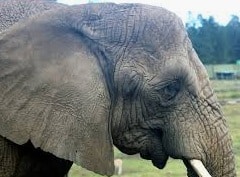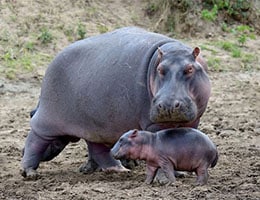 The notion of pachyderm comes from the Greek word pachýdermos , which can be translated as "thick-skinned." The term is used to refer to certain mammalian animals whose skin is very thick and hard .
The notion of pachyderm comes from the Greek word pachýdermos , which can be translated as "thick-skinned." The term is used to refer to certain mammalian animals whose skin is very thick and hard .
It should be remembered that a mammal is a vertebrate (its skeleton has a skull and spine, and its central nervous system has a brain and spinal cord) with offspring that develop as embryos in the mother's breast and are then fed with the milk of the mother. female breasts. In the case of pachyderms, the concept specifically refers to mammals that are part of the groups of proboscidians , perissodactyls and artiodactyls .
The elephant is the best known pachyderm. It belongs to the order of proboscidians (it has a prehensile trunk and limbs with five fingers) and is the largest land animal.
These pachyderms have a small head and large ears. Their natural habitat is in Africa and Asia , where they live in the wild in national parks and nature reserves.
Hippos are also pachyderms. In this case, they are artiodactyls (their limbs display an even number of fingers, supporting at least two to walk) that are characterized by their huge mouths and short legs. Hippos are found in several African rivers.
Rhinos , meanwhile, are other members of the pachyderm group. These perissodactyls (their limbs end in hooves with odd toes), inhabitants of Africa and Asia , have as a distinctive feature a pointed snout with at least one horn in the nose sector.
It is important to note that the term pachyderm should not be used with total ease within the field of zoology, since it is a neologism that was invented to group together certain thick-skinned animals such as those mentioned in the previous paragraphs, but not just anyone. .
 In fact, this name has become obsolete for scientists. One of the main reasons is that they talk about a common trait that is not enough to associate these species with the same order : it is confusing to relate probiscideans, artiodactyls and prissodactyls just because some of them have very thick skin. . Therefore, the word pachyderm is not considered technical but vulgar.
In fact, this name has become obsolete for scientists. One of the main reasons is that they talk about a common trait that is not enough to associate these species with the same order : it is confusing to relate probiscideans, artiodactyls and prissodactyls just because some of them have very thick skin. . Therefore, the word pachyderm is not considered technical but vulgar.
The history of this name takes us to the beginning of the 19th century, when the French naturalist Georges Léopold Chrétien Frédéric Dagobert Cuvier used it in a taxonomy table to highlight the thickness of the skin of certain animals he had studied. Also known as Baron de Cuvier or Chrétien , he was a pioneer in promoting paleontology and comparative anatomy .
Precisely, comparative anatomy is a discipline that focuses on the differences and similarities between different organisms from a physical point of view. Currently, it is part of the phylogeny and descriptive morphology. Returning to the concept of pachyderm , as time went by, zoology began to prioritize the internal characteristics of the anatomy over the external ones, and it was along this path that other ways of classifying different species emerged.
It should be noted that Cuvier was not the first to have used the word pachyderm to refer to thick skin, but rather it had been coined at least a century earlier, as demonstrated by the existence of certain 17th century documents written in France. If we refer to its Greek roots, we can find evidence that the philosopher and scientist Aristotle had used an equivalent term in the 4th century BC. C., almost two thousand years before.
